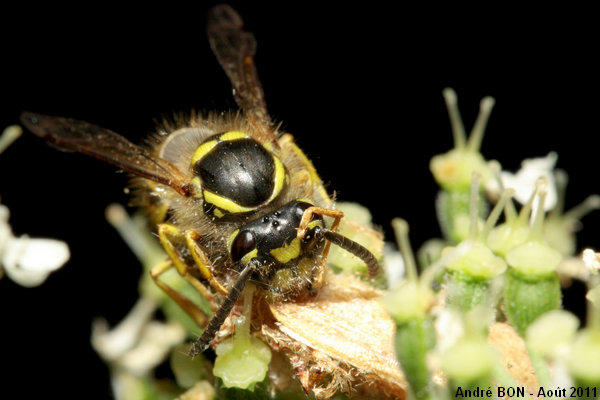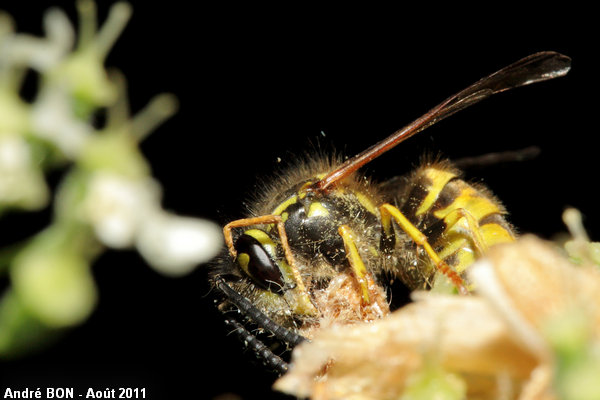

| Common Wasp (Vespula vulgaris (Linnaeus, 1758)) |


|
|
Scientific name: Vespula vulgaris (Linnaeus, 1758) Common name: Common Wasp French name: Guêpe commune Order: Hymenoptera Family: Vespidae Wingspan : Workers: 9 to 14 mm; Males: 13 to 17 mm; Queen: 16 to 19 mm. Biotope: Various habitats, forests, meadows, gardens, etc. Geographic area: Eurasia. Introduced to Australia and New Zealand. Observation period : Female queens having over wintered appear about at mid-March. Female workers appear in early summer and can fly up to mid-November. Other females and males also grow in summer. Mated females will over winter while male and female workers will die at the first cold days. |
The Common Wasp is a rather large size social wasp. The abdomen, of 6 segments on females and of 7 segments on males, is yellow with black stripes. There are four yellow spots at the rear of the thorax. The two ones at the back are very close to each other. The yellow stripes on the side of the prothorax show a uniform width. Like for all wasps, a front view of the face is key for telling the species apart. The members of the Vespula genus have a short face. The malar space is very short, that's to say the lower edge of the eye almost touches the mandible. You can tell the Common Wasp apart with the anchor-shaped black mark on the clypeus. The eye notches and the back of the eyes are yellow. Males have antennae with 13 articles. Females have antennae with 12 articles. The nests are often located under ground and sometimes in tree holes or old walls. They can contain 2000 wasps. The wasps of the Dolichovespula genus differ by their long head (large distance between the lower edge of the eye and the mandible). The German Wasp (Vespula germanica) is very similar. However it shows three small black dots forming a triangle on the clypeus and the yellow stripes on the side of the prothorax are extended downwards in the middle. |
| [To know more about the Common Wasp] [Next picture] [Top] |

|
The bottom of the eye is very close to the mandible. So this one is a wasp of the Vespula genus. You can't see the black marks on the clypeus covered with pollen. The yellow stripe on the side of the prothorax has a uniform width. There is a small yellow spot just below. Then this one is a Common Wasp. |
| [To know more about the Common Wasp] [Previous picture] [Top] |

|
Side view of the same wasp. |